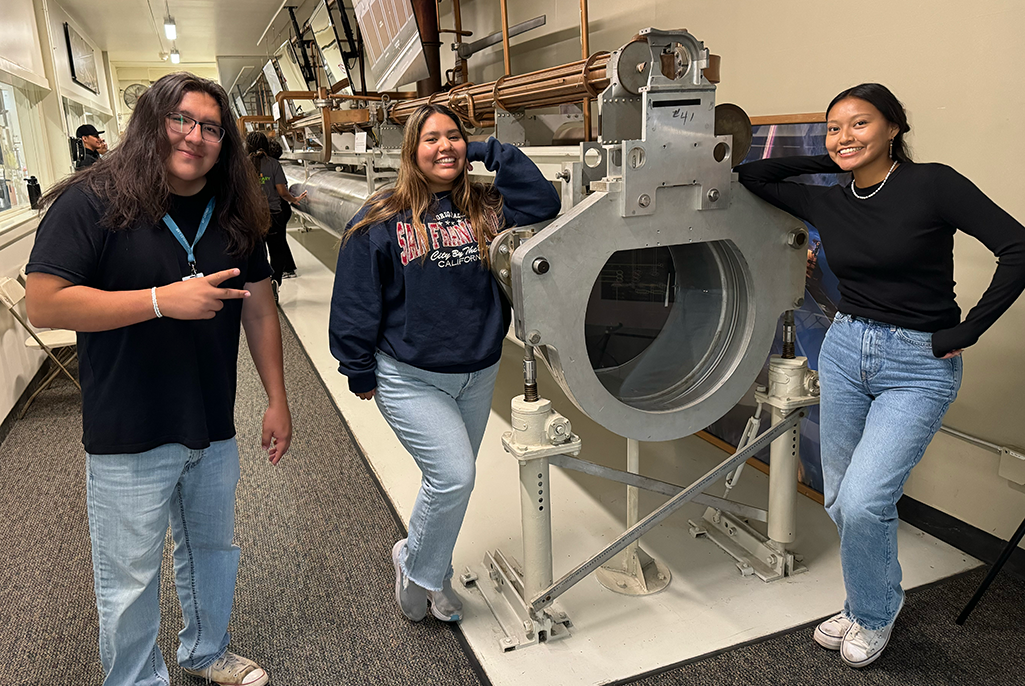This summer, Berkeley Lab hosted four interns as part of the Arizona State University-Berkeley Lab STEM Pathways program, which was conceived in 2021 to increase the number of Native American students in STEM graduate programs. The hope is that many will go on to become professional scientists and engineers.
Trent Northen, a senior scientist and the deputy of science for the Environmental Genomics & Systems Biology Division in the Biosciences Area at Berkeley Lab, helps lead the program.
Northen earned a doctorate from ASU where he met fellow scientist Gary Moore, from the Powhatan Nation, in the same National Science Foundation fellowship program as Northen. The two went on to work together at Berkeley Lab before Moore accepted a faculty position teaching molecular sciences at ASU, but they kept in touch.
Moore and Northen shared a common interest in helping address the inequities among Native Americans in science. According to the Postsecondary National Policy Institute, in 2020, Native American students made up 0.6 percent of all postsecondary enrollment.
“When I saw the NSF statistics, that in the entire U.S., there were only a few PhDs awarded to Native Americans across many STEM fields, I felt like we had a clear opportunity to make a difference,” Northen said in a recent interview with Elements. “Gary felt the same way, so we started brainstorming ideas on increasing Native American representation in graduate programs by giving ASU students hands-on research experience at Berkeley Lab.”
Northen and Moore met with the Berkeley Lab Foundation’s Alicia Chang, who clued them into a funding opportunity from the Alfred P. Sloan Foundation. Together with initial help from Workforce Development & Education’s Colette Flood and ongoing planning and program management from WD&E’s Laleh Coté, they sent a proposal and received funding from the Sloan Foundation to develop this new program. They recruited Native American students from ASU, which has a large Native American student population relative to other universities.
Over the past few years, Northen, Moore, and Coté have worked closely together on strategic planning and coordinating activities at both institutions.
Now in its second year, the program has so far supported seven students to serve as summer interns at Berkeley Lab, “giving them the chance to experience real science research and hopefully decide they want to pursue science as a career,” Northen said.
Leveraging her background in educational research, Coté is studying the impact of these programs on the student interns. “Of course people are interested to know if this new program was effective in supporting diversity-related goals, but our study will also provide some insights into the personal experiences and ideas of the students themselves,” she said.
The students were housed at UC Berkeley’s International House and participated in experiments ranging from Kaela Henry’s project at the Lab’s Advanced Biofuels and Bioproducts Process Development Unit working on biological carbon dioxide conversion to aviation fuel to Tonana Ben’s project studying novel genetic elements involved in craniofacial development in the Lab’s Mammalian Functional Genomics Laboratory. Jonathan Goldtooth, a civil engineering student, interned with the Lab’s Facilities Division with the hope of bringing the knowledge he learned back to his reservation. Goldtooth worked on this project under the guidance of the division’s Jocelyn Walker and Erik Zalkin.
“Berkeley Lab is almost like a whole little city in the sense of its infrastructure,” Northen explained. “The Facilities Division had been wanting to have a survey of all of the lights on the entire site for a long time. Jonathan was excited about taking that project on, and he helped build a map and made recommendations for changes that he thought would be good to include.”
The project team also welcomed Hannah Nockideneh, an ASU double major in physics and mathematics, who also participated in the program last year. She worked in the Lab’s Accelerator Technology and Applied Physics Division. With two successful internships under her belt, Nockideneh is interested in conducting more research in laser physics after graduation.
Ben, an intern from the Navajo Nation, is in her third year of undergraduate school and a first-generation college student who interned with the Berkeley Lab’s Environmental Genomics & Systems Biology Division, under the guidance of mentors Axel Visel, Laura Cook, and Neil Slaven.
“Even though I had a minimal background in genetics, I felt like my lab worked with me and my knowledge so far,” Ben said. “They took things one step at a time. They were very patient with me in the learning process, and I feel I was lucky to have such a supportive lab group, not only my mentors but the lab as a whole.”
Ben plans to apply to intern again at Berkeley Lab next summer to continue to develop her research skills in genetics research.
Cook, a postdoctoral fellow who helped to mentor her, said the intern’s primary interest was in public health but said Ben “dove straight in and enthusiastically took up the challenge of being in a lab that maybe wasn’t her first preference or her initial career trajectory.”
“The impact on these students is huge,” Cook added. “They’ve gained confidence in their scientific skills and their ability to have a research career. And, personally, I love being involved in the program. I learn a lot from the students, particularly how Navajo culture interacts with the students’ aspirations and approaches to scientific questions”
“I’m a really big believer that research is the best when we have a diversity of thought, and we can have that diversity of thought when we have a diversity of researchers.”
